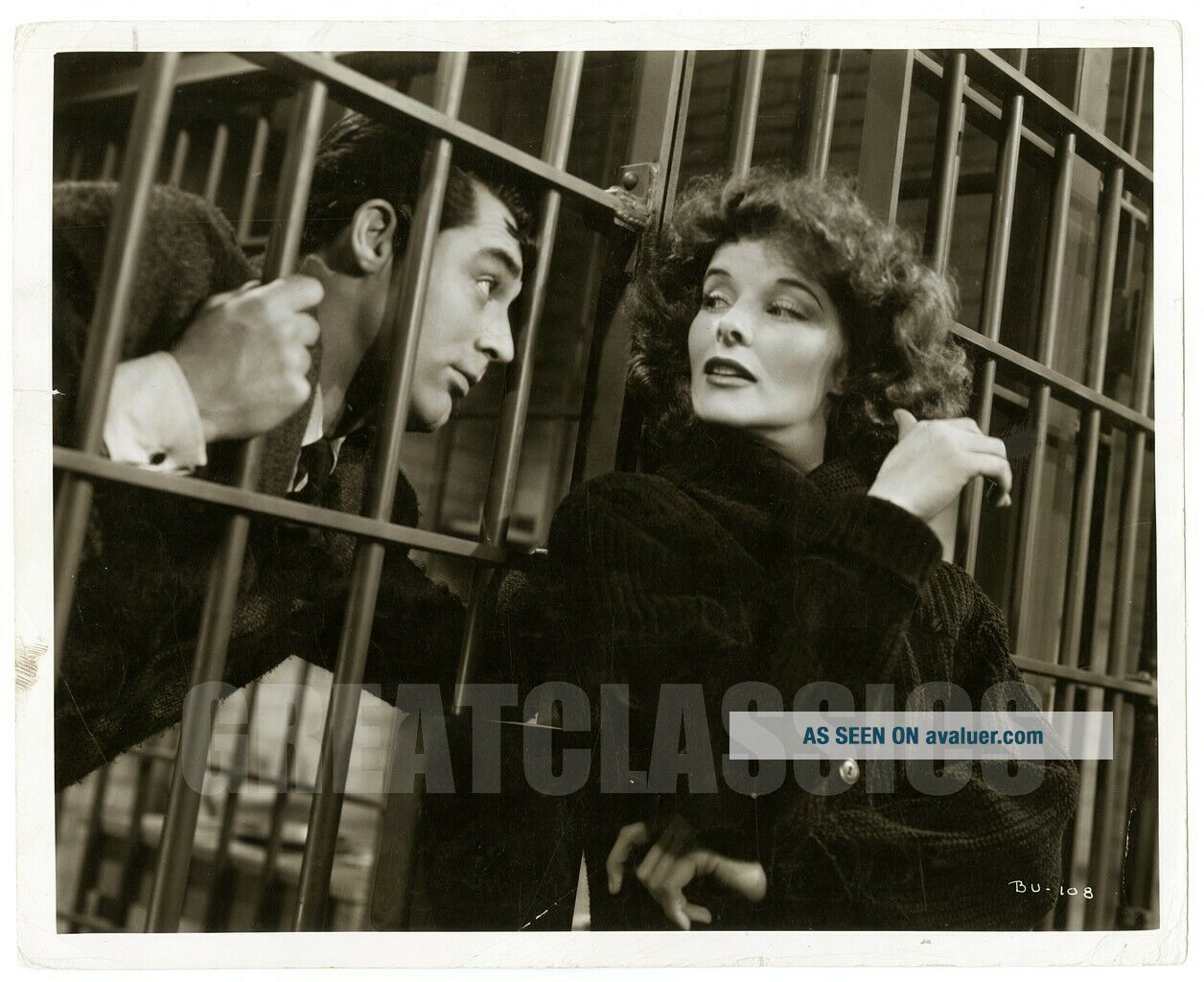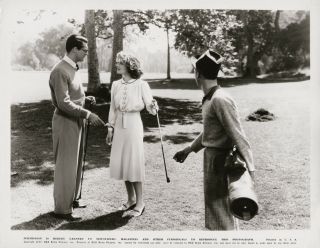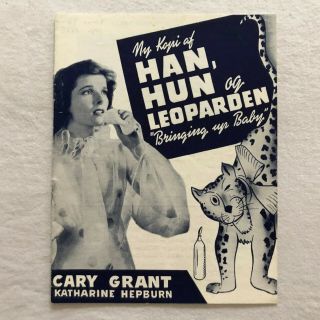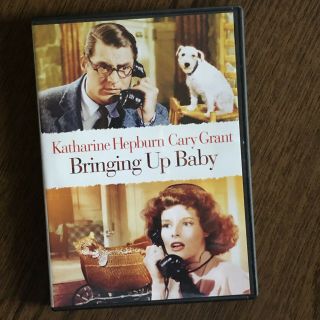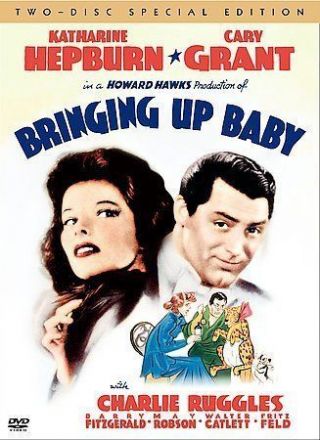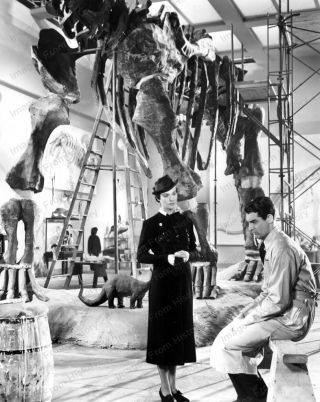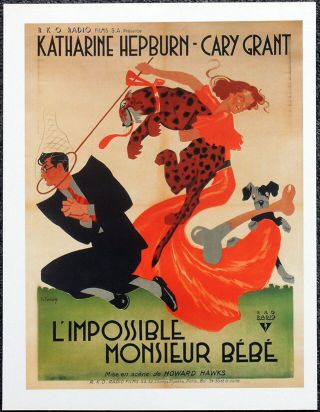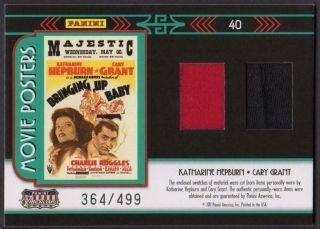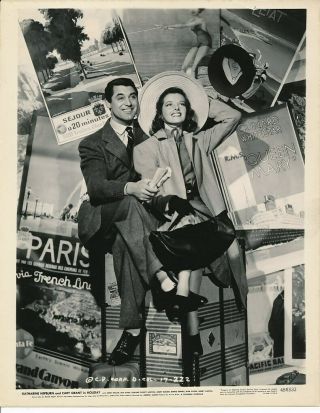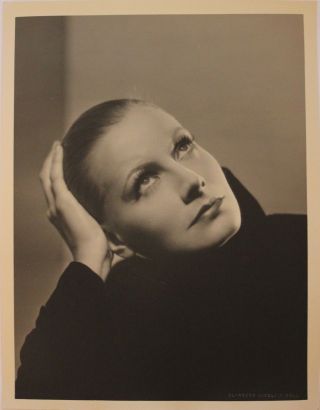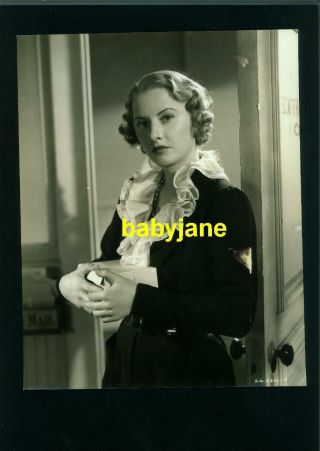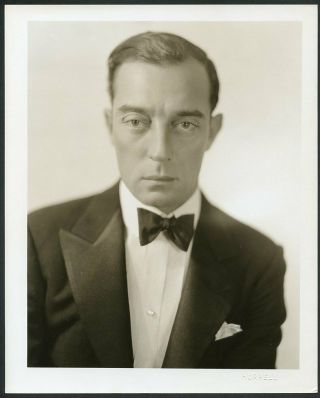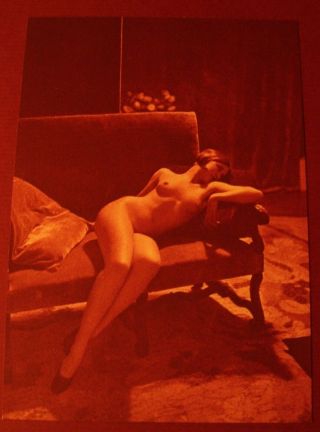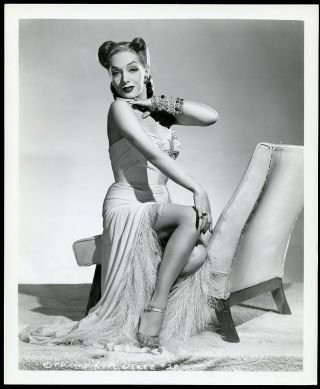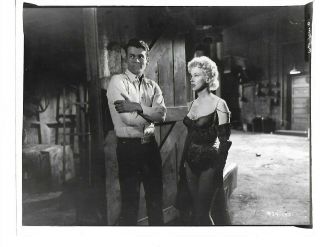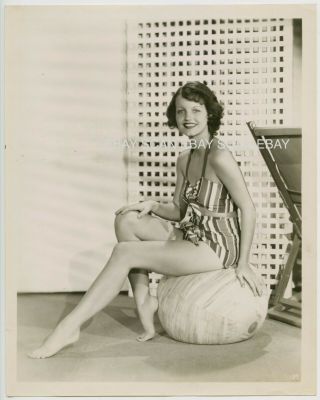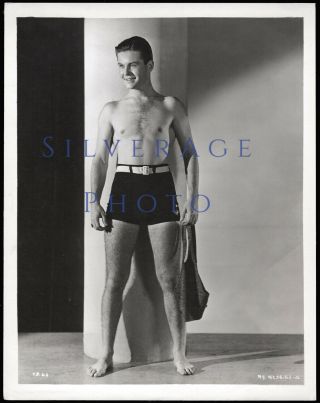KATHARINE HEPBURN CARY GRANT BRINGING UP BABY 1938 VINTAGE PHOTOGRAPH
Item History & Price
| Reference Number: Avaluer:12576359 |
(May 12, 1907 – June 29, 2003) was an American actress of film, stage, and television. A film icon, in 1999, she was ranked by the American Film Institute as the greatest female star in the history of American cinema.Raised in Connecticut by wealthy parents, after graduation, Hepburn turned to acting. Favorable reviews of her work on stage in 1932 brought her to the notice of Hollywood. After a few early film successes, including her first Oscar for Morning Glory, she endured a string of flops, which led to her being voted "box office poison". Fortunately, she had a great triumph starring in the Broadway play The Philadelphia Story. She obtained the film rights with the help of Howard Hughes and sold them to Metro-Goldwyn-Mayer on the condition that she reprise her leading role as Tracy Lord. The hit film adaptation revived her flagging career.Over the course of her long life, she costarred with such screen legends as Cary Grant (Bringing Up Baby, Holiday, The Philadelphia Story), Humphrey Bogart (The African Queen), John Wayne (Rooster Cogburn), and Henry Fonda (On Golden Pond). However, her greatest teaming, both on-screen and off, was with Spencer Tracy, beginning with 1942's Woman of the Year. They fell in love and conducted a decades-long affair that was kept secret from the general public. (Tracy was married and, as a Catholic, could not divorce his wife.) The last of their nine films together was Guess Who's Coming to Dinner (1967), which was completed shortly before his death.Hepburn holds the record for the most Best Actress Oscar wins with four, out of 12 nominations. Hepburn won an Emmy Award in 1976 for her lead role in Love Among the Ruins, and was nominated for four other Emmys, two Tony Awards and eight Golden Globes.Hepburn was born in Hartford, Connecticut, the daughter of suffragette Katharine Martha Houghton (1878 – 1951) (an heiress to the Corning Glass fortune and co-founder of Planned Parenthood) and Dr. Thomas Norval Hepburn (1879 – 1962), who was a successful urologist from Virginia with Maryland roots. Her siblings were Thomas Houghton Hepburn (1905–1921), Richard Houghton Hepburn (1911–2000), Robert Houghton Hepburn (1913–2007), Marion Houghton Hepburn Grant (1918–1986) and Margaret Houghton Hepburn Perry (1920–2006).Hepburn's father insisted the girls swim, ride, and play golf and tennis. Hepburn won a bronze medal for figure skating from the Madison Square Garden skating club, shot golf in the low eighties and reached the semi final of the Connecticut Young Women's Golf Championship. Hepburn especially enjoyed swimming, and regularly took dips in the frigid waters that fronted her bayfront Connecticut home, generally believing that "the bitterer the medicine, the better it was for you." She continued her brisk swims well into her 80s. Hepburn would come to be recognized for her athletic physicality—she fearlessly performed her own pratfalls in films such as Bringing Up Baby (1938).On April 3, 1921, while visiting friends in Greenwich Village, Hepburn found her older brother Tom (born November 8, 1905), whom she idolized, hanging from the rafters of the attic by a rope, an apparent suicide. Her family denied it was self-inflicted, arguing he had been a happy boy. They insisted it must have been an experiment gone awry. It has been speculated he was trying to carry out a trick he saw in a play with Katharine. Hepburn was devastated and sank into a depression. She shied away from other children and was mostly home-schooled. For many years she used Tom's birthday (November 8) as her own. It was not until her 1991 autobiography, Me: Stories of My Life, that Hepburn revealed her true birth date of May 12, 1907.Hepburn was educated at the Oxford School (now Kingswood-Oxford School) in West Hartford, Connecticut, before going on to Bryn Mawr College. Hepburn was suspended for breaking curfew and smoking, which at that time was particularly not encouraged for women. Decades later, Hepburn also confirmed that after dark, she would go swimming naked in the college's "Cloisters" fountain. She received a degree in history and philosophy in 1928, the same year she had her debut on Broadway after landing a bit part in Night Hostess.A banner year for Hepburn, 1928 also marked her marriage to socialite businessman Ludlow ("Luddy") Ogden Smith, whom she had met while at Bryn Mawr and married after a short engagement. Hepburn and Smith's marriage was turbulent, and they spent less and less time living together as Hepburn pursued her career on the stage and traveled. They were divorced in Mexico in 1934. Fearing that the Mexican divorce was not legal, Ludlow obtained a second divorce in the United States in 1942 and a few days later he remarried. Katharine Hepburn often expressed her gratitude toward Ludlow for his financial and moral support in the early days of her career. "Luddy" continued to be a lifelong friend to her and the Hepburn family.On September 21, 1938, Hepburn was staying in her family's Old Saybrook, Connecticut beach home when the 1938 New England Hurricane struck and destroyed the house. Hepburn, her mother, brother and servants narrowly escaped before the home was lifted off its foundations and washed away. She stated in her 1991 book entitled Me that she lost 95% of her belongings in the storm, including her 1932–1933 best actress Oscar, which was later found intact.Hepburn developed her acting skills during her time at Bryn Mawr. There, Hepburn met Eddie Knopf, a young producer with a stock company in Baltimore, Maryland, who cast her in several small roles, including a production of The Czarina and The Cradle Snatchers.Her first leading role was in a production of The Big Pond, which opened in Great Neck, New York. The producer dismissed the original actress at the last moment, and substituted Hepburn. Terror stricken, Hepburn arrived late and stumbled over her lines, tripped over her feet and spoke so fast she was almost incomprehensible. She was also dismissed, but continued to understudy and gain small stock company roles.Hepburn was cast in the Broadway play Art and Mrs. Bottle. Hepburn was dismissed from this role too, although she was later rehired when the director could not find a replacement. After another summer of stock companies, in 1932, Hepburn landed the role of Antiope the Amazon princess in The Warrior's Husband (an update of Lysistrata), which required her to wear a very short costume, and received excellent reviews. Hepburn became the talk of New York City, and was noticed in Hollywood.In the play, Hepburn entered the stage by jumping down a flight of steps while carrying a large stag on her shoulders — an RKOLeland Hayward, whom she would later romance) was so impressed by this display of physicality that he asked her to do a screen test for A Bill of Divorcement, which starred John Barrymore, David Manners, and Billie Burke. scout (She demanded $1, 500 per week for film work (at the time she was earning between $80 and $100 per week), assuming RKO would refuse. To her surprise, after seeing her screen test, RKO agreed to her demands and cast her. At 5 feet, 7 inches (1.71 m), Hepburn was one of the tallest leading ladies of the day. The director George Cukor became a lifetime friend and colleague. Barrymore pinched her posterior on the set in one of many attempts to seduce her. She said, "If you do that again I'm going to stop acting." Barrymore replied, "I wasn't aware that you'd started, my dear." After the positive audience reaction to A Bill of Divorcement, RKOMorning Glory, as a young actress who rejects romance in favor of her career. That same year, Hepburn played Jo in the screen adaptation of Little Women, which broke box-office records, and for which she won the Best Actress award at the Venice Film Festival.
signed Hepburn to a new contract. But her non-conformist, anti-Hollywood behavior off screen made studio executives fret she would never become a major star. The following year (1933), Hepburn won her first Oscar inIntoxicated by her success, Hepburn wanted to return to the theater. She chose The Lake, but RKO would not release her and she made the forgettable Spitfire. Having satisfied RKO, Hepburn went immediately back to Manhattan to begin the play, in which she played an English girl unhappy with her overbearing mother and weak father. The play was generally considered a flop, and Hepburn's performance elicited Dorothy Parker's quip that the actress "ran the gamut of emotions from A to B."In 1935, in the title role of the film Alice Adams, Hepburn earned her second Oscar nomination. By 1938, Hepburn was an established star, and her forays into comedy with the films Bringing Up Baby and Stage Door were well-received critically. But audience response to the two films was tepid, and the good reviews from the critics were not enough to rescue her from an earlier string of flops (The Little Minister, Spitfire, Break of Hearts, Sylvia Scarlett, A Woman Rebels, Mary of Scotland, Quality Street). As a result, Hepburn's movie career began to decline.Katharine Hepburn would often come to interviews dressed in men's suits, saying that it was "comfortable". Without meaning to, she made a fashion statement, and women who admired her started wearing trousers, which was not encouraged at the time.Some of what has made Hepburn greatly beloved today—her unconventional, straightforward, anti-Hollywood attitude—at the time began to turn audiences sour. Outspoken and intellectual with an acerbic tongue, she defied the era's conventions, preferring to wear pantsuits and disdaining makeup. She also had a famously difficult relationship with the press, turning down most interviews, which did not help her image with the public. On her first outing with the Hollywood press corps after the success of A Bill of Divorcement, Hepburn talked with reporters who had invaded her and her husband's cabin aboard the ship City of Paris. A reporter asked if they were really married; Hepburn responded, "I don't remember." Following up, another reporter asked if they had any children; Hepburn's answer: "Two white and three colored". Hepburn's aversion to media attention did not thaw until 1973, when she appeared on The Dick Cavett Show for an extended two-day interview.Hepburn could also be prickly with fans; though she relented as she aged, early in her career Hepburn often denied requests for autographs. However, on movie sets, she was eager to learn the ways of the stage and camera crews and befriended many of them. Even so, her refusal to sign autographs and answer personal questions earned her the nickname "Katharine of Arrogance" (an allusion to Catherine of Aragon). Soon, audiences began to stay away from her movies.Hepburn was affected by a series of flops when, in 1938, she — along with Fred Astaire, Mae West, Joan Crawford, Dolores del Río, Marlene Dietrich, and others — was voted "box office poison" in a poll taken by exhibitors. In 1939, Hepburn was going to do producer David O. Selznick a favor and play the role of Scarlett O'Hara because he did not yet have anyone else signed for the role. Hepburn insisted that she did not have the lustful sex appeal that the part demanded and told Selznick that his studio needed to find the woman who did. Hepburn rehearsed the lines thoroughly just in case. The night before the deadline, Selznick finally cast Vivien Leigh. Unknown to Hepburn and the rest of Hollywood, Leigh was long favored for the role, but as an English actress, she was deemed unsuitable. Her affair with Laurence Olivier, while he was in the middle of a divorce, made her a controversial choice. The vast "search for Scarlett" was orchestrated to make it seem as if no other actress could be found, thus limiting the shock of Vivien Leigh landing the role. Hepburn was later the maid of honor at Leigh and Olivier's wedding in 1940. Hepburn remained a close friend of Vivien Leigh until Leigh's death in 1967.Hepburn yearned for a comeback on the stage. Philip Barry wrote a play especially for her, The Philadelphia Story, a year after she had starred in the film version of his play Holiday. In the new play, her portrayal of spoiled socialite Tracy Lord received rave reviews. With the help of ex-lover Howard Hughes, she acquired the film rights and sold them to MGM; the resulting film was one of the biggest hits of 1940. As part of the deal with MGM, Hepburn got to choose the director, George Cukor, but not the costars she wanted: Clark Gable and Spencer Tracy. Instead, the roles went to Cary Grant and James Stewart respectively. The documentary Cary Grant — A Class Apart states that Hepburn was allowed the choice for her final male lead once Gable was unavailable, and that, with $100, 000 to use, Katharine chose her friend and favorite costar, Cary Grant. She was nominated for an Academy Award for Best Actress for her work and won the New York Film Critics award. Her career was revived almost overnight.At the height of the pre-McCarthy stages of the post-war Second Red Scare, Hepburn's strongly progressive social views also became a target of anti-communist hysteria. Myron Fagan, the right-wing writer, producer and director at the center of Hollywood's anti-communist witch-hunting denounced her after Hepburn had spoken up on behalf of fellow actors, directors, and screenwriters facing the notorious blacklist of the 1940s. Despite Hepburn's lack of actual membership in (or any formal links to) the American Communist Party, Fagan, in his polemical speech against "the Reds" in Hollywood, named Hepburn as "an example", forwarding the claim that "Katharine Hepburn's love for Joe Stalin is no secret"Hepburn made her first appearance with Spencer Tracy in Woman of the Year (1942), directed by George Stevens. Behind the scenes the pair fell in love, beginning what would become one of Hollywood's most famous romances, despite Tracy's life long unwillingness (he was a Catholic) to divorce his estranged wife, the former Louise Treadwell, whom he had married in 1923.Hepburn and Tracy became one of Hollywood's most recognizable couples. Hepburn, with her agile mind and distinctive New England accent, complemented Tracy's working-class machismo. When Joseph Mankiewicz introduced them, Hepburn, who was wearing special heels that added several inches to her slender frame, said, "I'm afraid I'm too tall for you, Mr. Tracy." Mankiewicz retorted, "Don't worry, he'll soon cut you down to size." As The Daily Telegraph observed in Hepburn's obituary, "Hepburn and Spencer Tracy were at their most seductive when their verbal fencing was sharpest: it was hard to say whether they delighted more in the battle or in each other."Most of their films stress the difficulties that couples can have when they try to find an equable balance of power. The sparring over power and control is almost always resolved in an agreement to share. They appeared in nine movies together, including Keeper of the Flame (1942), Adam's Rib (1949), Pat and Mike (1952), Desk Set (1957) and Guess Who's Coming to Dinner (1967), for which Hepburn won her second Academy Award for Best Actress.Hepburn and Tracy carefully hid their affair from the public, using back entrances to studios and hotels and assiduously avoiding the press. They were undeniably a couple for decades, but did not live together regularly until the last few years of Tracy's life. Even then, they maintained separate homes to keep up appearances. Their relationship, which neither would discuss publicly, lasted until Tracy's death in 1967. Their relationship was complex and there were periods during which they were estranged. Tracy had several affairs while estranged from Hepburn, notably while filming Plymouth Adventure with his co-star Gene Tierney.Hepburn had had several prior liaisons, most notably with her agent Leland Hayward, John Ford and Howard Hughes. Tracy, however, seems to have been her true love. Hepburn took five years off after Long Day's Journey Into Night to care for Tracy while he was in failing health. Out of consideration for Tracy's family, Hepburn did not attend his funeral. She described herself as too heartbroken to ever watch Guess Who's Coming to Dinner, saying it evoked memories of Tracy that were too painful.One of Hepburn's Academy Award nominated performances was her role as Rose Sayer in The African Queen (1951), where she played a prim spinster missionary in Africa (around the time of World War I), who convinces Humphrey Bogart's character, a hard-drinking riverboat captain, to use his boat to destroy a German ship. Hepburn received her fifth Best Actress nomination, losing to Vivien Leigh for A Streetcar Named Desire.The African Queen was shot mostly on location in Africa, where almost all the cast and crew suffered from malaria and dysentery—except director John Huston and Bogart, neither of whom ever drank any water. (Many of the studio shots were completed in the unlikely location of Worton Hall aka Isleworth Studios which is sited in the Greater London suburb of Isleworth, West London.) Hepburn, ever the urologist's daughter, disapproved of the two men's drinking and piously drank gallons of water each day to spite them. She wound up so sick with dysentery that, even months after she returned home, the famously vigorous actress was still ill. The trip and the movie made such an impact on her that later in life she wrote a book about filming the movie: The Making of The African Queen: Or, How I Went to Africa With Bogart, Bacall and Huston and Almost Lost My Mind, which made her a best-selling author at the age of 77.In an interview in Playboy, Huston spoke of how on their days off, he and Bogart would go big game hunting, and how one day Hepburn asked to go along. He described her as a "Diana of the Hunt" — utterly fearless — and able to shoot with the best of them.Following The African Queen, Hepburn often played spinsters, most notably in her Oscar-nominated performances for SummertimeThe Rainmaker (1956), although at 49 some considered her too old for the role. She also received nominations for her performances in films adapted from stage dramas, namely as Mrs. Venable in Tennessee Williams' Suddenly, Last Summer (1959) and as Mary Tyrone in the 1962 version of Eugene O'Neill's Long Day's Journey Into Night, for which the cast received a special jury prize at the Cannes Film Festival. (1955) andHepburn received her second Best Actress Oscar for Guess Who's Coming to Dinner, though she believed it was meant to honor Spencer Tracy, who had died shortly after filming was completed. The following year, she won a record-breaking third Oscar for her role as Eleanor of Aquitaine in The Lion in Winter, an award shared that year with Barbra Streisand for her performance in Funny Girl.Peter O'Toole, her co-star in The Lion in Winter, said in many interviews, including with host Charlie Rose, that Hepburn was his favorite actor to work with. He and Hepburn remained friends until her death.Hepburn continued to do filmed stage dramas, including The Madwoman of Chaillot (1969), The Trojan Women (1971) by Euripides, and Edward Albee's A Delicate Balance (1973). In 1973, she first appeared in an original television production of Tennessee Williams' The Glass Menagerie.Two years later, Hepburn received an Emmy Award for Outstanding Lead Actress in a Special Program (Drama or Comedy) for Love Among the Ruins, which co-starred friend Laurence Olivier and was directed by George Cukor. Hepburn also appeared in one of her most well received roles of her later period with John Wayne in Rooster Cogburn, the sequel to Wayne's Academy Award winning film True Grit. Rooster Cogburn was essentially The African Queen done as a western. Hepburn won her fourth Oscar for On Golden PondHenry Fonda. In 1994, Hepburn gave her final three movie performances — One Christmas, based on a short story by Truman Capote, as Ginny in the remake of Love Affair; and This Can't Be Love, directed by one of her close friends, Anthony Harvey (The Lion in Winter). (1981), withIn later years, Hepburn developed essential tremor, a chronic neurological condition that causes involuntary shaking of the head, hands, and feet.On June 29, 2003, Hepburn died of natural causes at Fenwick, the Hepburn family home in Old Saybrook, Connecticut. She was 96 years old, and was buried in Cedar Hill Cemetery, Hartford, Connecticut in the family plot. In honor of her extensive theater work, the lights of Broadway were dimmed for an hour.The book Kate Remembered, by A. Scott Berg, was published just 13 days after Hepburn's death.In 2004, in accordance with Hepburn's wishes, her personal effects were put up for auction with Sotheby's in New York. Hepburn had meticulously collected an extraordinary amount of material relating to her career and place in Hollywood over the years, as well as personal items such as a bust of Spencer Tracy she sculpted herself (used as a prop in Guess Who's Coming to Dinner on the desk where Sidney Poitier makes his phone call) and her own oil paintings. The auction netted several million dollars, which Hepburn willed mostly to her family and close friends, including television journalist Cynthia McFadden.Hepburn's genealogy has been researched through the Whittier line back to King Louis IX of France (a great grandson of King Henry II and Queen Eleanor of Aquitaine, whom she played in The Lion in Winter). She is listed as one of the descendants of the Mayflower compact author William Brewster (her family tree). In her 1973 interview on The Dick Cavett Show, Hepburn stated that although she agreed with Christian principles and thought highly of Jesus Christ, she did not believe in religion or the afterlife. Her paternal grandfather, Sewell Snowden Hepburn, was an Episcopal clergyman, but on the subject of religion, she told another journalist (this time a Ladies Home Journal reporter) in October 1991 that:I'm an atheist and that's it. I believe there's nothing we can know except that we should be kind to each other and do what we can for other people.In 1910, the Hepburn family lived at 133 Hawthorne Street in Hartford, Connecticut. Eight years later, they were recorded living at 352 Laurel Street, also in Hartford. By 1930, Katharine's parents and four younger siblings had moved to a large eight bedroom house at 201 Bloomfield Avenue in West Hartford. As of 2007, the house is owned by the University of Hartford.Margaret "Peg" Perry, Hepburn's last surviving sister, died on February 13, 2006, aged 85. Perry was a librarian in Canton, Connecticut.Robert Hepburn, the last surviving sibling of Katharine Hepburn, died on November 26, 2007. Robert was a doctor who followed in the footsteps of their father, Dr. Thomas Hepburn. He was the head of the urology department at Hartford Hospital for more than 30 years.Hepburn's professional legacy is carried on within her family. Her niece is actress Katharine Houghton, who appeared as her daughter in Guess Who's Coming to Dinner. Hepburn's grandniece is actress Schuyler Grant, who appeared in Anne of Green GablesAll My Children. andTo honor Hepburn, a theater is being built in Old Saybrook, Connecticut. Hepburn lived and died in the Fenwick section of Old Saybrook. During the spring of 2009, the state-of-the-art Katharine Hepburn Cultural Arts Center and Theater was opened. In October 2007, the town of Old Saybrook received a check for $200, 000 from the Connecticut Commission on Culture and Tourism, Historic Restoration Grant for the Katharine Hepburn Cultural Arts Center and Theatre, totaling one million dollars received in grants for this project.On September 8 and 9, 2006, Bryn Mawr College, Hepburn's alma mater, launched the Katharine Houghton Hepburn Center, dedicated to both the actress and her mother. At the launch celebration, Lauren Bacall and Blythe Danner were awarded Katharine Hepburn Medals for "lives, work and contributions that embody the intelligence, drive and independence of the four-time-Oscar-winning actress."Hepburn lent her name to some liberal social and political causes, particularly family planning. In 1985, she received the Humanist Arts Award of the American Humanist Association, presented by her friend Corliss Lamont.Hepburn, who resided in a brownstone located at 244 East 49th Street in the borough of Manhattan of New York City, was honored posthumously by neighbors in her community, Turtle Bay. First, a garden near her home was dedicated in her name in 2004. The garden contains 12 stepping stones each inscribed with quotes. One reads:I remember when walking as a child, it was not customary to say you were fatigued. It was customary to complete the goal of the expedition.In addition to the garden, the intersection of East 49th Street and 2nd Avenue has been renamed Katharine Hepburn Way by the city.To mark the 100th anniversary of her birth in May 2007, the cable channel Turner Classic Movies dedicated a week of its evening broadcast hours to her films and documentaries on her life. Warner Brothers Home video also celebrated the 100th anniversary of her birth by releasing a box set of movies not previously available on DVD – Morning Glory (1933), Sylvia Scarlett (1936), Dragon SeedWithout Love (1945), Undercurrent (1946), and the TV movie The Corn Is Green (1979). (1944), In the 2004 Howard Hughes biopic The Aviator, Hepburn was portrayed by Cate Blanchett, who won the Academy Award for Best Supporting Actress for her performance. It marked the first instance when an Academy Award–winning actress was turned into an Academy Award–winning role.In the "Legends of Hollywood" stamp series, Hepburn was honored as being the sixteenth star to earn her own stamp. These commemorative stamps were unveiled in Old Saybrook, CT and became available for sale in U.S. post offices on May 12, 2010, which would've been her 103rd birthday.Awards Academy Award Academy Award for Best Actress Wins 1933: Morning Glory 1967: Guess Who's Coming to Dinner 1968: The Lion in Winter 1981: On Golden Pond Nominations 1935: Alice Adams 1940: The Philadelphia Story 1942: Woman of the Year 1951: The African Queen 1955: Summertime 1956: The Rainmaker 1959: Suddenly, Last Summer 1962: Long Day's Journey into Night Golden Globe Award Best Actress in a Motion Picture Drama Nominations 1957: The Rainmaker 1960: Suddenly, Last Summer 1963: Long Day's Journey into Night 1968: Guess Who's Coming to Dinner 1969: The Lion in Winter 1982: On Golden Pond Best Actress in a Miniseries or Motion Picture Made for Television Nominations 1993: The Man Upstairs Best Actress in a Motion Picture Musical or Comedy Nominations 1953: Pat and Mike Emmy Award Best Actress in a Drama Nominations 1974: The Glass Menagerie Best Actress in a Miniseries or a Movie Wins 1975: Love Among the Ruins Best Actress in a Limited Series or Special Nominations 1979: The Corn is Green 1986: Mrs. Delafield Wants to Marry BAFTA Award Best Actress Wins 1969: Guess Who's Coming to Dinner 1969: The Lion in Winter 1983: On Golden Pond Best Foreign Actress Nominations 1952: Pat and Mike 1955: Summertime 1957: The Rainmaker Tony Award Best Actress in a Musical Nominations 1969: Coco Best Actress in a Play Nominations 1981: The West Side Waltz Cannes Film Festival Best Actress Award 1962: Long Day's Journey into Night Venice Film Festival Volpi Cup for Best Actress 1934: Little Women Stage credits Night Hostess (1928) These Days (1928) Art and Mrs. Bottle (1930) The Warrior's Husband (1932) The Lake (1934) Jane Eyre (1936–1937) The Philadelphia Story (1938) Without Love (1942) As You Like It (1950) The Millionairess (1952) The Merchant of Venice, Measure for Measure, and The Taming of the Shrew (1955)—On tour in Australia with the Old Vic The Merchant of Venice and Much Ado About Nothing (1957)—Stratford, Connecticut Shakespeare Theatre Antony and Cleopatra and Twelfth Night (1960)—Stratford, Connecticut Shakespeare Theatre Coco (1969) (Tony Award nomination for Leading Actress in a Musical) A Matter of Gravity (1976) The West Side Waltz (1981) (Tony Award nomination for Leading Actress in a Play) Features Year # Title Role Leading Man Director 1932 1 A Bill of Divorcement Sidney Fairfield John Barrymore George Cukor 1933 2 Christopher Strong Lady Cynthia Darrington Colin Clive Dorothy Arzner 3 Morning Glory Eva Lovelace Douglas Fairbanks, Jr. Lowell Sherman 4 Little Women Josephine "Jo" March Paul Lukas George Cukor 1934 5 Spitfire Trigger Hicks Robert Young John Cromwell 6 The Little Minister Babbie John Beal
Alan Hale Richard Wallace 1935 7 Break of Hearts Constance Dane Charles Boyer Philip Moeller 8 Alice Adams Alice Adams Fred MacMurray George Stevens 9 Sylvia Scarlett Sylvia Scarlett Cary Grant George Cukor 1936 10 Mary of Scotland Mary Stuart Fredric March John Ford 11 A Woman Rebels Pamela Thislewaite Herbert Marshall Mark Sandrich 1937 12 Quality Street Phoebe Throssel Franchot Tone George Stevens 13 Stage Door Terry Randall Adolphe Menjou Gregory La Cava 1938 14 Bringing Up Baby Susan Vance Cary Grant Howard Hawks 15 Holiday Linda Seton Cary Grant George Cukor 1940 16 The Philadelphia Story Tracy Lord Cary Grant
James Stewart George Cukor 1942 17 Woman of the Year Tess Harding Spencer Tracy George Stevens 18 Keeper of the Flame Christine Forrest Spencer Tracy George Cukor 1943 19 Stage Door Canteen Herself Frank Borzage 1944 20 Dragon Seed Jade Walter Huston
Turhan Bey Jack Conway 1945 21 Without Love Jamie Rowan Spencer Tracy Harold S. Bucquet 1946 22 Undercurrent Ann Hamilton Robert Taylor
Robert Mitchum Vincente Minnelli 1947 23 The Sea of Grass Lutie Cameron Spencer Tracy Elia Kazan 24 Song of Love Clara Wieck Schumann Paul Henreid
Robert Walker Clarence Brown 1948 25 State of the Union Mary Matthews Spencer Tracy Frank Capra 1949 26 Adam's Rib Amanda Bonner Spencer Tracy George Cukor 1951 27 The African Queen Rose Sayer Humphrey Bogart John Huston 1952 28 Pat and Mike Patricia "Pat" Pemberton Spencer Tracy George Cukor 1955 29 Summertime Jane Hudson Rossano Brazzi David Lean 1956 30 The Rainmaker Lizzie Curry Burt Lancaster Joseph Anthony 31 The Iron Petticoat Vinka Kovelenko Bob Hope Ralph Thomas 1957 32 Desk Set Bunny Watson Spencer Tracy
Gig Young Walter Lang 1959 33 Suddenly, Last Summer Violet Venable Montgomery Clift Joseph L. Mankiewicz 1962 34 Long Day's Journey Into Night Mary Tyrone Ralph Richardson
Jason Robards Jr.
Dean Stockwell Sidney Lumet 1967 35 Guess Who's Coming to Dinner Christina Drayton Spencer Tracy
Sidney Poitier Stanley Kramer 1968 36 The Lion in Winter Eleanor of Aquitaine Peter O'Toole Anthony Harvey 1969 37 The Madwoman of Chaillot Aurelia, The Madwoman of Chaillot Charles Boyer Bryan Forbes 1971 38 The Trojan Women Hecuba Patrick Magee Michael Cacoyannis 1973 39 A Delicate Balance Agnes Paul Scofield Tony Richardson 1975 40 Rooster Cogburn Eula Goodnight John Wayne Stuart Millar 1978 41 Olly, Olly, Oxen Free Miss Pudd Kevin McKenzie
Dennis Dimster Richard A. Colla 1981 42 On Golden Pond Ethel Thayer Henry Fonda Mark Rydell 1984 43 George Stevens: A Filmmaker's Journey George Stevens, Jr 1985 44 Grace Quigley Grace Quigley Nick Nolte Anthony Harvey 1994 45 Love Affair Ginny Warren Beatty Glenn Gordon Caron
(courtesy of wikipedia)



